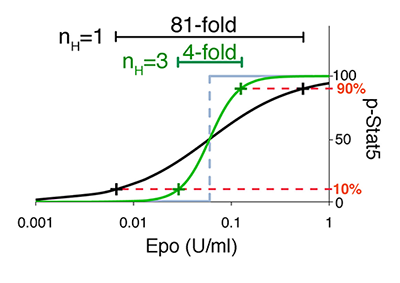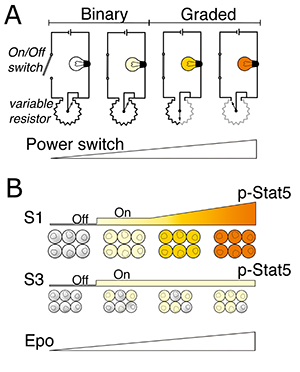Stat5 Signaling Dynamics
We address a fundamental question in cell signaling, asking whether the dynamics of the signaling response encodes information beyond that already contained in the identity of the signaling molecule. We examined this question with respect to Stat5, a key member of the signal transducer and activator of transcription (STAT) protein family. Stat5 transduces signals by multiple hematopoietic cytokines, including Epo, and has a prominent role in blood cancers.
In erythropoiesis, Stat5 is one of the principal secondary messengers activated by the erythropoietin receptor (EpoR). Once active, it induces transcription of a number of genes including those required for erythroblast survival and for expression of cell surface Transferrin receptor, which transports iron into cells. Stat5 is essential for both basal and stress erythropoiesis. Mice deleted for the two Stat5 genes, Stat5a and Stat5b, die before birth as a result of severe anemia [1, 2]. A key challenge lies in understanding how Stat5 signaling elicits the distinct erythroblast responses required by basal and stress erythropoiesis. We found that the dynamic behavior of the Stat5 signal helps to specify either a stress, or a basal, cellular response program.
 Figure 1: Hypothetical dose/response curves for EpoR-phoshpho-Stat5 signaling. The grey line shows an idealized switch response. An infinitesimally small increase in Epo results in an increase of the pStat5 response from 0% to 100%. The black curve shows a graded response with a Hill coefficient (nH) = 1. An 81-fold increase in Epo is required to shift the pStat5 response from 10% to 90% of maximum. The green curve shows a much steeper, switch-like or binary dose/response curve (nH = 3). Only a 4-fold change in Epo is required in order to increase the pStat5 response from 10% to 90% of maximum.
Figure 1: Hypothetical dose/response curves for EpoR-phoshpho-Stat5 signaling. The grey line shows an idealized switch response. An infinitesimally small increase in Epo results in an increase of the pStat5 response from 0% to 100%. The black curve shows a graded response with a Hill coefficient (nH) = 1. An 81-fold increase in Epo is required to shift the pStat5 response from 10% to 90% of maximum. The green curve shows a much steeper, switch-like or binary dose/response curve (nH = 3). Only a 4-fold change in Epo is required in order to increase the pStat5 response from 10% to 90% of maximum.
Specifically, Stat5 combines two signaling modalities: binary (also referred to as 'digital'), and graded (also known as 'analog') [3]. These modalities describe two extremes of the possible spectrum of stimulus/response curves (Figure 1). Graded high-intensity signaling predominates in early erythroblasts and is essential for the erythropoietic stress response. Binary low-intensity signaling predominates in later erythroblasts and is essential for basal erythropoiesis and for survival of the whole organism. The combination of binary, low intensity signaling with graded, high intensity signaling resembles a dimmer switch (Figure 2). It allows Stat5 to transduce with high-fidelity throughout the very wide, 3-orders of magnitude concentration range of Epo in blood during health and disease [3]. Our work places Stat5 within a small group of pathways known to date to signal via the binary modality: the MAPK pathway in Xenopus oocytes, and Ras signaling in T-cells. In work that is ongoing, we are investigating the mechanism underlying binary Stat5 activation, with potential applications to the many hematological cancers in which Stat5 is constitutively active.

Figure 2: Stat5 signaling in erythroblasts resembles a dimmer switch, combining binary and graded components. In Panel A, the closing of an 'on/off' switch turns on a dim light. Gradual turning of a variable resistor dial permits a gradual decrease of the circuit's resistance, with a consequent graded increase in the electric current and light intensity. Panel B shows a binary, decisive but low-intensity p-Stat5 signal (in yellow) in mature, S3 erythroblasts. Increasing Epo concentration increases the number of S3 cells with the binary 'on' signal, but not the intensity of the pStat5 signal. By contrast, in earlier, S1 erythroblasts, the pStat5 signal increases in a graded manner with increasing Epo concentration (represented by a change in the color from yellow to orange) [3].
References:
1. Socolovsky, M., Fallon, A.E.J., Wang, S., Brugnara, C., and Lodish, H.F. (1999). Fetal anemia and apoptosis of red cell progenitors in Stat5a-/-5b-/- mice: a direct role for Stat5 in bcl-XL induction. Cell 98, 181-191.
2. Cui, Y., Riedlinger, G., Miyoshi, K., Tang, W., Li, C., Deng, C.X., Robinson, G.W., and Hennighausen, L. (2004). Inactivation of Stat5 in mouse mammary epithelium during pregnancy reveals distinct functions in cell proliferation, survival, and differentiation. Mol Cell Biol 24, 8037-8047.
3. Porpiglia, E., Hidalgo, D., Koulnis, M., Tzafriri, A.R., and Socolovsky, M. (2012). Stat5 signaling specifies basal versus stress erythropoietic responses through distinct binary and graded dynamic modalities. PLoS Biol 10, e1001383.
